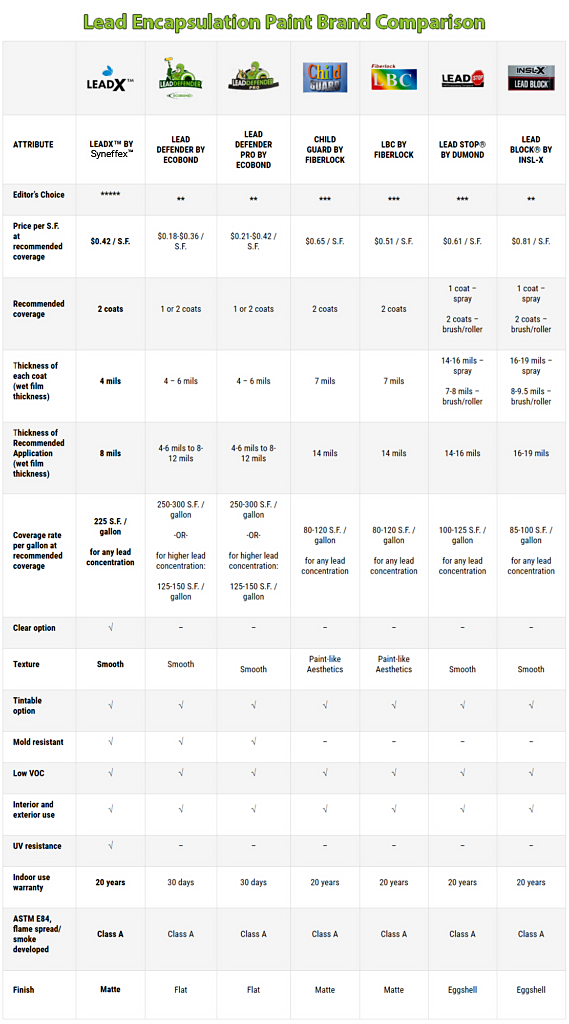When you’re dealing with a surface that has tested positive for lead, it can be confusing knowing how to deal with it. It can also be expensive if you aren’t sure about the differences between lead abatement and lead encapsulation and the difference between a lead encapsulation paint and a sealant.
Lead abatement can include multiple forms of remediation of a lead hazard from a home or building to make it safe for inhabitants, including:
- Complete removal of lead paint (including capturing any dust that might be generated from sanding)
- Enclosing the lead with a secondary containment (additional wall or ceiling)
- Demolition to completely remove the lead contaminated structure
- Encasing the lead with a lead encapsulating paint (paint over it with the proper type of lead sealant)
Lead encapsulation is very effective, but the cost is much lower than the other methods, which is why it’s a popular route to take for remediating lead paint issues and getting a clean inspection. According to Home Advisor, costs for lead abatement range from:
- $8 to $17 per S.F. for removal
- $10 per S.F. for enclosure
- Up to $15,000 per project for demolition
How much does it cost to encapsulate lead paint and lead contaminated surfaces as compared to the options above?
- $0.42 to $0.81 per S.F. for lead encapsulation with an encapsulating paint
So, those wondering, “Can you paint over lead paint to seal it?” will be happy to know that you can and the the best value actually happens to be Syneffex™ LeadX™ encapsulating paint, which comes in at $0.42 per S.F. and has additional benefits that the other competitive products on the market don’t have.
See our lead encapsulating paint comparison chart below

Make Sure You’re Getting an Encapsulant NOT Just a Sealer
Some people make the mistake of thinking that a surface sealer can be used for lead encapsulation. The fact is that, while a lead encapsulation paint does seal in the lead to make the surface safe, it is a very specialized chemistry and it is not the same thing as a general paint or surface sealer.
A surface sealer is generally designed to seal surfaces from moisture and the elements and they may also be vapor barriers. They are not specifically made to encapsulate lead and should not be used for that purpose. If you try to use a general sealant for lead abatement, you could end up wasting time and money and having the surface still test positive for lead.
A lead encapsulating paint or coating is specifically formulated to encapsulate lead and will have been tested for this purpose. When you properly apply a lead encapsulating coating over a lead contaminated area, the coating surface should test negative for lead.
In order for an encapsulant to be used, the surface needs to be free of any flaking paint and any existing paint should be adhering well to the surface. LeadX™ can be used over multiple surface types including; lead paint (that’s adhering well), wood, metal, brick, concrete, and more.
An additional consideration is that you generally want a breathable coating that won’t cause moisture build up. LeadX™ is breathable, while also being extremely moisture repellent and mold/mildew resistant.
Need a clear encapsulant or a custom color? We can do that too! We offer LeadX™ clear lead encapsulating paint as well as LeadX™ white or custom tint lead encapsulating coating.
So, when it comes to abating lead, using a lead encapsulating paint is an excellent, effective, and economical option. Just make sure you use a product that is specifically formulated for lead encapsulation.
Get a LeadX™ Project Specification Today!
LeadX™ is the number one lead encapsulation product choice of multiple organizations. It’s been used by the U.S. Navy, U.S. Coast Guard, U.S. Army Corps of Engineers, City of Rochester New York, and for multiple other lead abatement projects, including in the historical preservation arena.




